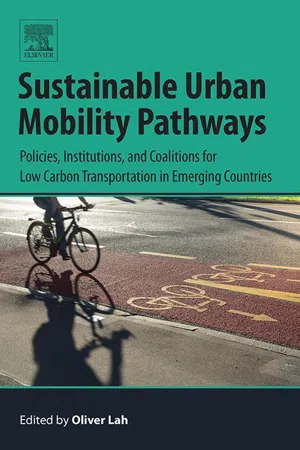
Sustainable Urban Mobility Pathways
Policies, Institutions, and Coalitions for Low Carbon Transportation in Emerging Countries
- 308 pages
- English
- ePUB (mobile friendly)
- Available on iOS & Android
Sustainable Urban Mobility Pathways
Policies, Institutions, and Coalitions for Low Carbon Transportation in Emerging Countries
About This Book
Sustainable Urban Mobility Pathways examines how sustainable urban mobility solutions contribute to achieving worldwide sustainable development and global climate change targets, while also identifying barriers to implementation and strategies to overcome them. Building on city-to-city cooperation experiences in Europe, Asia, Africa and Latin America, the book examines key challenges in the context of the Paris Agreement, UN Sustainable Development Goals and the New Urban Agenda, including policies needed to achieve a sustainable, low-carbon pathway for transport and how an integrated policy strategy is designed to provide a basis for political coalitions.
The book explores which institutional framework creates sufficient political stability and continuity to foster the take-up of and long-term support for sustainable transport strategies. The linkages of climate change and wider sustainable development objectives are covered, including success stories, best practices, and quantitative analysis for key emerging economies in public transport, walking, cycling, freight and logistics, vehicle technology and fuels, urban planning and integration, and national framework policies.
- Provides a holistic view of sustainable urban transport, focusing on policy-making processes, the role of institutions and successes and pitfalls
- Delivers practical insights drawn from the experiences of actual city-to-city cooperation and on-the-ground policy work
- Explores options for the integration of policy objectives and institutional structures that form coalitions for the implementation of sustainable urban mobility solutions
- Describes the policy, institutional, political, and socio-economic aspects in cities in five emerging economies: Brazil, China, India, Mexico, and Turkey
Frequently asked questions
Information
Trends, Drivers, and Pathways for Sustainable Urban Mobility
Abstract
- • Decarbonization of the transport sector is not possible through isolated measures. A broad range of local and national actions are needed to bring the sectors on to a low-carbon development path.
- • A holistic policy approach is needed to deliver on wider sustainable development objectives. Addressing a broader range of policy objectives can help forming coalitions and consensus among key political and societal actors.
- • Consensus-oriented institutions are needed to maintain a stable policy environment that enables the long-term transitions towards a low-carbon development path.
Keywords
Introduction
- Trends, drivers and pathways: What are the key trends and drivers in the transport sector, what is the greenhouse gas emission reduction potential, and how can mitigation pathways contribute to sustainable development as a lever for broad coalitions?
- Potential for cobenefits: What policies are needed to achieve a sustainable, low-carbon pathway for transport, what barriers have to be overcome and how would an integrated policy strategy need to be designed to provide a basis for political coalitions?
- Coalitions and institutions: What institutional framework creates sufficient political stability and continuity to foster the take-up of and long-term support for sustainable transport strategies?
Trends, Drivers, and Pathways
Table of contents
- Cover image
- Title page
- Table of Contents
- Copyright
- List of Contributors
- Introduction
- Chapter 1. Trends, Drivers, and Pathways for Sustainable Urban Mobility
- Chapter 2. Sustainable Urban Mobility Solutions for Asia, Latin America and the Mediterranean Region
- Chapter 3. Decarbonization Scenarios for Transport and the Role of Urban Mobility
- Chapter 4. Opportunities for Synergies and Cobenefits
- Chapter 5. Governance and Institutions for a Long-Term Transition to Low-Carbon Mobility
- Chapter 6. National Urban Mobility Policy Frameworks
- Chapter 7. Sustainable Urban Mobility in Action
- Index